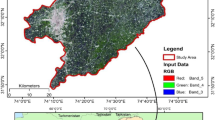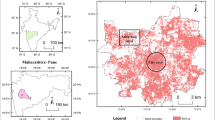Abstract
Spatial and spectral features are two important attributes that form the knowledge based database, useful in classification of engineered objects, using remote sensing data. Spectral features alone may be insufficient to identify buildings and roads in urban areas due to spectral homogeneity and similarity exhibited by them. This has led researchers to explore the spatial features described in terms of shape descriptors to improve accuracy of classification of engineered objects. This paper discusses the parameters of spatial shape features and the method for implementing these features for improving the extraction of engineered objects, using the support vector machine (SVM). SVM classified results obtained using spatial shape features is compared with gray level co-occurrence statistical features in which the former has shown better classification accuracy for buildings and roads. The classification accuracy is also calculated using spectral features of buildings and roads by classifiers such as spectral angle mapper and spectral information divergence. The analysis shows that spatial shape features improve the classification results of buildings and roads in urban areas.














Similar content being viewed by others
References
Aksoy S et al (2005) Multi-resolution segmentation and shape analysis for remote sensing image classification. In: IEEE international conference on recent advances in space technology
Angelov P, Sadeghi-Tehran P, Ramezani R (2010) An approach to automatic real-time novelty detection, object identification, and tracking in video streams based on recursive density estimation and evolving Takagi–Sugeno fuzzy systems. Int J Intell Syst 26(3):189–205
Bayram U, Can G, Duzgun S, Yalabik N (2011) Evaluation of textural features for multispectral images. In: XVII Proceedings on image and signal processing for remote sensing. SPIE, p 8180
Benediktsson JA, Pesaresi M, Arnason K (2003) Classification and feature extraction for remote sensing images from urban areas based on morphological transformations. IEEE Trans Geosc Remote Sens 41(9):1940–1949
Borchani M, Stamon G (1997) Texture features for image classification and retrieval. In: Proceedings on multimedia storage and archiving systems II, SPIE 3229
Camps-Valls G, Bruzzone L (2005) Kernal-based methods for hyperspectral image classification. IEEE Trans Geosci Remote Sens 43(6):1351–1362
Celebi ME (2012) A simple and efficient algorithm for connected component labeling in color images. Image Process Algorithms Syst X Parallel Process Imaging Appl II 8295(1)
Chang F, Chen C-J, Lu C-J (2004) A linear time component labelling algorithm using contour tracing technique. Comput Vis Image Underst 93(2):206–220
Congalton RG (2001) Accuracy assessment and validation of remotely sensed and other spatial information. Int J Wildland Fire 10(4):321–328
Dong Y, Milne AK, Forster BC (2001) Segmentation and classification of vegetated areas using polarimetric SAR image data. IEEE Trans Geosci Remote Sens 39(2):321–329
Dong Y, Forster BC, Milne AK (2009) Segmentation of radar imagery using Gaussian Markov random field model. Int J Remote Sens 20(8):1617–1639
Gu X, Angelov PP, Zhang C, Atkinson PM (2018) A massively parallel deep rule-based ensemble classifier for remote sensing scenes. IEEE Geosci Remote Sens Lett 15(3):345–349
Guide EUS (2008) ENVI On-line software user’s manual. ITT Visual Information Solutions
Halldorsson GH, Benediktsson JA, JR Sveinsson (2004), Source based feature extraction for support vector machines in hyperspectral classification. Proc IEEE Int Geosci Remote Sens Symp 536–539
Han Y, Kim H, Choi J, Kim Y et al (2012) A shape–size index extraction for classification of high resolution multispectral satellite images. Int J Remote Sens 33(6):1682–1700. https://doi.org/10.1080/01431161.2011.599348
Hasani H, Samadzadegan F (2015) 3D Object classification based on thermal and visible imagery in urban area. Int Arch Photogramm Remote Sens Spat Inform Sci XL-1/W5
Herold M, Roberts DA, Gardner ME et al (2004) Spectrometry for urban area remote sensing—development and analysis of a spectral library from 350 to 2400 nm. Remote Sens Environ 91:304–319
Huang X, Zhang L, Li P (2007) Classification and extraction of spatial features in urban areas using high-resolution multispectral imagery. IEEE Geosci Remote Sens Lett 4(2):260–264
Huang X, Zhang L, LI P (2008) Classification of very high spatial resolution imagery based on the fusion of edge and multispectral information. Photogramm Eng Remote Sens 74:1585–1596
IEEE GRSS (2014) Data fusion contest, presented to image analysis and data fusion technical committee. IEEE Geoscience and Remote Sensing Society (GRSS)
Im J, Lu Z, Rhee J, Quackenbush LJ (2012) Impervious surface quantification using a synthesis of artificial immune networks and decision/regression trees from multi-sensor data. Remote Sens Environ 117:102–113
Kruse F et al (1993) The spectral image processing system (SIPS)—interactive visualization and analysis of imaging spectrometer data. Remote Sens Environ 44(2):145–163
Ll M, Zang S et al (2018) Spatial and temporal variation of the urban impervious surface and its driving forces in the central city of Harbin. J Geography Sci 28(3):323–336
Luca D et al (2014) Assessing the performance of two unsupervised dimensionality reduction techniques on hyperspectral APEX data for high resolution urban land-cover mapping. ISPRS J Photogramm Remote Sens 87:166–179
Lv ZY et al (2014) Morphological profiles based on differently shaped structuring elements for classification of images with very high spatial resolution. IEEE J Sel Topics Appl Earth Obs Remote Sens 7(12):4644–4652
Maimaiti B, Ding J, Simayi Z, Kasimu A (2017) Characterizing urban expansion of Korla city and its spatial-temporal patterns using remote sensing and GIS methods. J Arid Land 9(3):458–470
Melgani F, Bruzzone L (2004) Classification of hyperspectral remote sensing images with support vector machines. IEEE Trans Geosci Remote Sens 42(8):1778–1790
Myint SW, Lam NSN, Taylor JM (2004) Wavelets for urban spatial feature discrimination: comparisons with fractal, spatial autocorrelation, and spatial co-occurence approaches. Photogramm Eng Remote Sens 70(7):803–812
Nithya S, Ramakrsishnan S (2018) Local line directional neighbourhood pattern for texture classification. EURASIP J Image Video Process. https://doi.org/10.1186/s13640-018-0347-x
Ouma YO, Tetuko J, Tateishi R (2008) Analysis of co-occurrence and discrete wavelet transform textures for differentiation of forest and non-forest vegetation in very-high resolution optical-sensor imagery. Int J Remote Sens 29:3417–3456
Pesaresi M, Benediktsson JA (2001) A new approach for the morphological segmentation of high-resolution satellite imagery. IEEE Trans Geosci Remote Sens 39(2):309–320
Petropoulos GP, Kalivas DP et al (2015) Urban vegetation cover extraction from hyperspectral imagery and geographic information system spatial analysis techniques: case of Athens, Greece. J Appl Remote Sens 9(1):096088
Sargana AB et al (2017) A comprehensive review on handcrafted and learning-based action representation approaches for human activity recognition. Appl Sci 7(1):110
Shackelford AK, Davis CH (2003) A combined fuzzy pixel-based and object-based approach for classification of high-resolution multispectral data over urban areas. IEEE Trans Geosci Remote Sens 41:2354–2363
Shi W, Miao Z, Wang Q, Zhang H (2014) Spectral–spatial classification and shape features for urban road centerline extraction. IEEE Geosci Remote Sens Lett 11(4):788–792
Small C (2003) High spatial resolution spectral mixture analysis of urban reflectance. Remote Sens Environ 88:170–186
Small C (2016) Projecting the urban future: contributions from remote sensing. Spat Demogr 4(1):17–37
Usman M, Liedl R, Shahid MA, Abbas A (2015) Land use/land cover classification and its change detection using multi-temporal MODIS NDVI data. J Geogr Sci 25(12):1479–1506
Van der Linden S, Janz A, Waske B et al (2007) Classifying segmented hyperspectral data from a heterogeneous urban environment using support vector machines. J Appl Remote Sens 1(1):013543
Weng Q (2012) Remote sensing of impervious surfaces in the urban areas: requirements, methods, and trends. Remote Sens Environ 117:34–49
Zhang Y (1999) Optimisation of building detection in satellite images by combining multispectral classification and texture filtering. ISPRS J Photogramm Remote Sens 54:50–60
Zhang L, Huang X, Huang B, Li P (2006) A pixel shape index with spectral information for classification of high spatial resolution remotely sensed imagery. IEEE Trans Geosci Remote Sens 44(10):2950–2961
Zhang E, Zhang X, Yang S, Wang S (2014) Improving hyperspectral image classification using spectral information divergence. IEEE Geosci Remote Sens Lett 11(1):249–253
Zhou X, Angelov P (2006) Real-time joint landmark recognition and classifier generation by an evolving fuzzy system. In: IEEE international conference on fuzzy system, pp 1205–1212
Zhou X, Angelov P (2007) Autonomous visual self-localization in completely unknown environment using evolving fuzzy rule-based classifier. In: IEEE Conference on computational intelligence in security and defence applications 131–138
Zhu C, Yang X (1998) Study of remote sensing image texture analysis and classification using wavelet. Int J Remote Sens 19(16):3197–3203
Author information
Authors and Affiliations
Corresponding author
Additional information
Publisher’s Note
Springer Nature remains neutral with regard to jurisdictional claims in published maps and institutional affiliations.
Rights and permissions
About this article
Cite this article
Vohra, R., Tiwari, K.C. Spatial shape feature descriptors in classification of engineered objects using high spatial resolution remote sensing data. Evolving Systems 11, 647–660 (2020). https://doi.org/10.1007/s12530-019-09275-8
Received:
Accepted:
Published:
Issue Date:
DOI: https://doi.org/10.1007/s12530-019-09275-8




